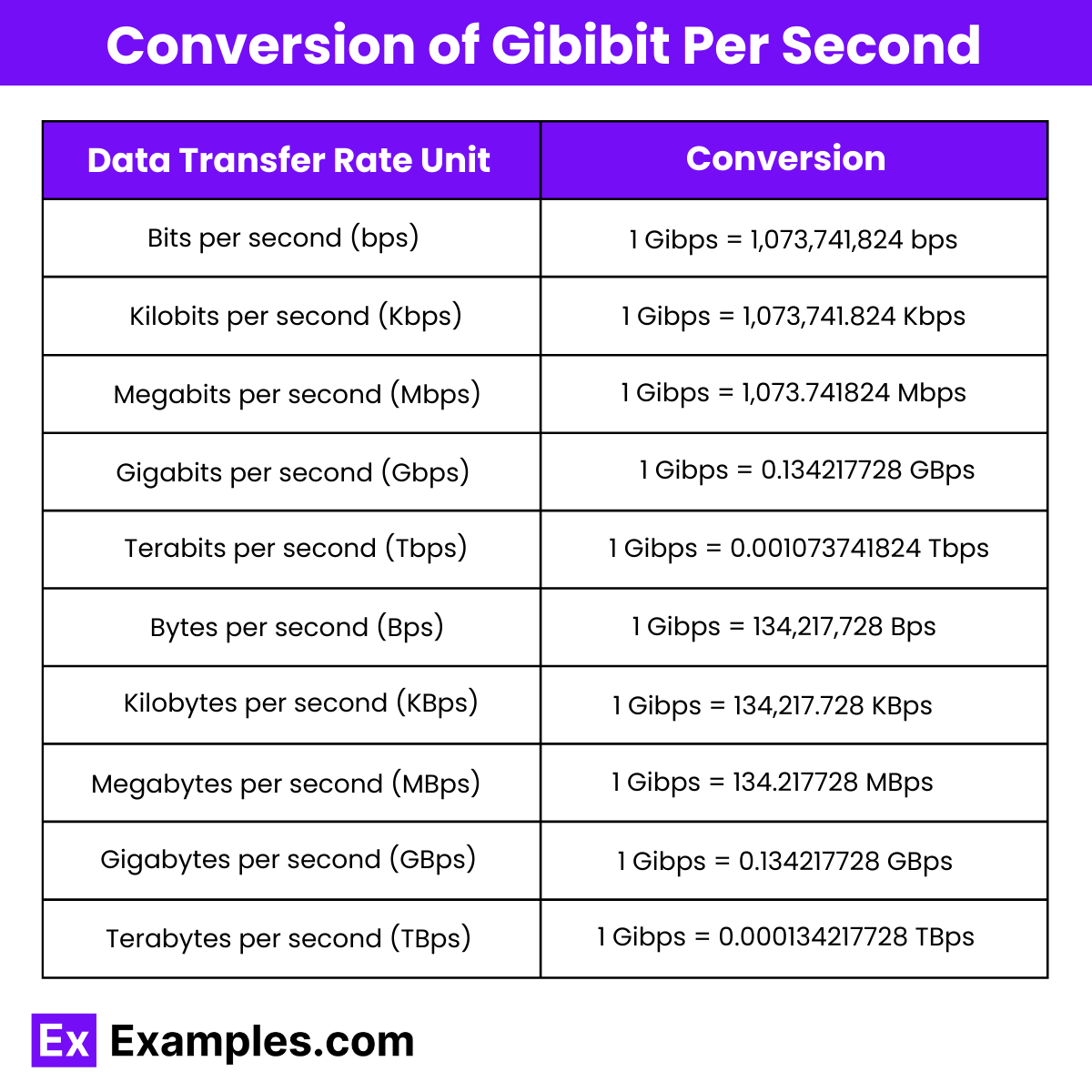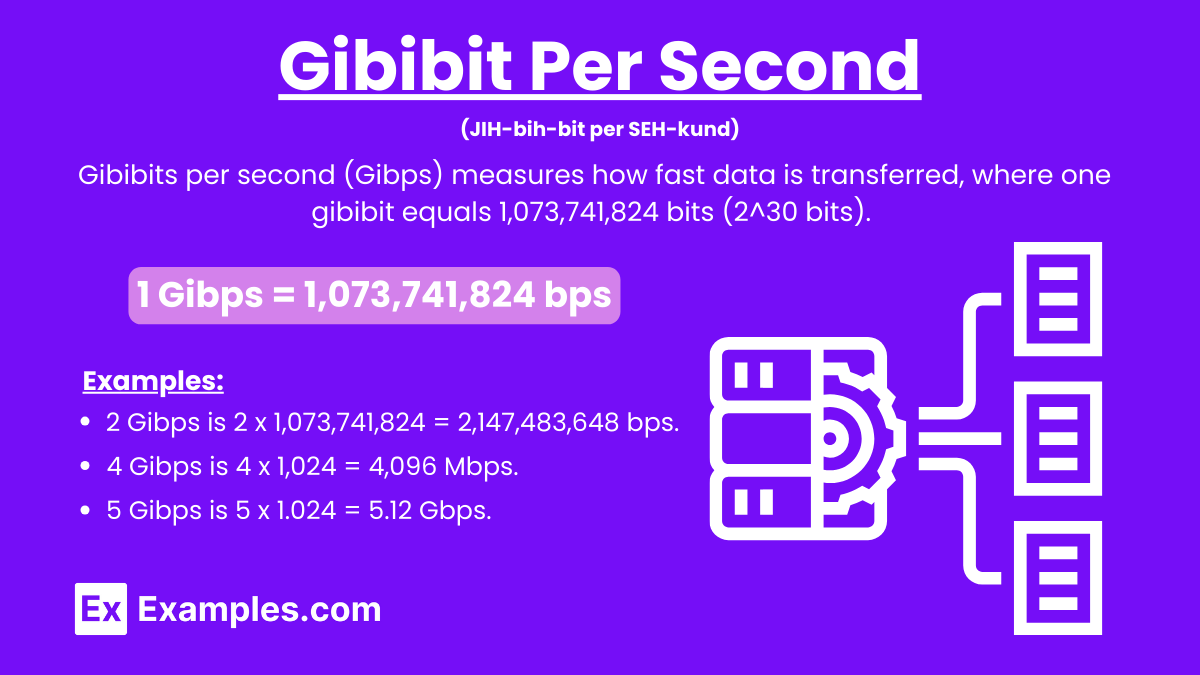15+ Gibibit Per Second Examples
Gibibits per second (Gibps) is a unit of measurement for data transfer rate, indicating the number of gibibits transmitted or received each second. One gibibit is equivalent to 1,073,741,824 bits, which aligns with the binary system used in computing and data processing. This unit is commonly used to quantify data transfer speeds in networks, computer systems, and digital communication channels, providing a precise measurement that reflects the binary nature of digital data. In different contexts, other units of speed are used, such as foot per second, meter per second, and miles per second, to measure the velocity of objects. Each of these units provides a specific way to understand the rate at which something moves over a given second, whether it’s data through a network or physical objects in motion.
What is Gibibit Per Second?
Gibibits per second (Gibps) measures how fast data is transferred, where one gibibit equals 1,073,741,824 bits (2^30 bits). This unit is commonly used to describe the speed of high-capacity networks and digital communication systems. Higher Gibps values mean faster data transmission, which is crucial for efficiently handling large amounts of data. Understanding units of measurement is essential in various fields, including data transfer rates. Different measurement units are used to quantify speed and length, such as meters or feet. A measurement chart can help convert between these units, ensuring accuracy and clarity in communication.
Examples of Gibibit Per Second
- Data transfer rate for a high-speed internet connection
- Bandwidth of a data center network
- Transfer speed for large file backups
- Speed of data replication between cloud servers
- Rate of data transfer in a fiber optic network
- Streaming 4K video content from a media server
- High-performance computing data transfer
- Data synchronization between enterprise servers
- Speed of data migration in a cloud environment
- Bandwidth for a virtual private network (VPN)
- Data transfer rate in a SAN (Storage Area Network)
- High-speed data transfer in a research network
- Rate of data exchange in a blockchain network
- Data transfer speed in a financial trading system
- Speed of data transmission in a scientific research lab
Gibibit Per Second Formula
The formula to calculate the data transfer rate in gibibits per second (Gibps) is:
Data Transfer Rate (Gibps) = Time Taken (Seconds)/Total Data Transferred (Gibibits)
Steps to Use the Formula
- Determine the Total Data Transferred
- Measure the total amount of data transferred.
- Convert this amount to gibibits (Gib). If the data is in bits, divide the total number of bits by 1,073,741,824 (2^30) to get gibibits.
- Measure the Time Taken
- Measure the total time taken for the data transfer in seconds.
- Apply the Formula
- Divide the total data transferred (in gibibits) by the time taken (in seconds) to get the data transfer rate in gibibits per second (Gibps).
Conversion of Gibibit Per Second

| Unit | Conversion |
|---|---|
| Bits per second (bps) | 1 Gibps = 1,073,741,824 bps |
| Kilobits per second (Kbps) | 1 Gibps = 1,073,741.824 Kbps |
| Megabits per second (Mbps) | 1 Gibps = 1,073.741824 Mbps |
| Gigabits per second (Gbps) | 1 Gibps = 1.073741824 Gbps |
| Terabits per second (Tbps) | 1 Gibps = 0.001073741824 Tbps |
| Bytes per second (Bps) | 1 Gibps = 134,217,728 Bps |
| Kilobytes per second (KBps) | 1 Gibps = 134,217.728 KBps |
| Megabytes per second (MBps) | 1 Gibps = 134.217728 MBps |
| Gigabytes per second (GBps) | 1 Gibps = 0.134217728 GBps |
| Terabytes per second (TBps) | 1 Gibps = 0.000134217728 TBps |
Understanding how to convert data transfer rates to other common units is essential when dealing with different data speeds. Whether you’re configuring network settings, comparing internet speeds, or ensuring accurate data rates for projects, here’s a straightforward guide to converting data transfer rates to and from other common units:
Gibibits per second (Gibps) to Bits per second (bps)
Multiply the Gibps value by 1,073,741,824 to convert to Bits per second.
Example: 2 Gibps is 2 x 1,073,741,824 = 2,147,483,648 bps.
Gibibits per second (Gibps) to Kilobits per second (Kbps)
Multiply the Gibps value by 1,073,741.824 to convert to Kilobits per second.
Example: 3 Gibps is 3 x 1,073,741.824 = 3,221,225.472 Kbps.
Gibibits per second (Gibps) to Megabits per second (Mbps)
Multiply the Gibps value by 1,024 to convert to Megabits per second.
Example: 4 Gibps is 4 x 1,024 = 4,096 Mbps.
Gibibits per second (Gibps) to Gigabits per second (Gbps)
Multiply the Gibps value by 1.024 to convert to Gigabits per second.
Example: 5 Gibps is 5 x 1.024 = 5.12 Gbps.
Gibibits per second (Gibps) to Terabits per second (Tbps)
Multiply the Gibps value by 0.001024 to convert to Terabits per second.
Example: 6 Gibps is 6 x 0.001024 = 0.006144 Tbps.
Gibibits per second (Gibps) to Bytes per second (Bps)
Multiply the Gibps value by 134,217,728 to convert to Bytes per second.
Example: 7 Gibps is 7 x 134,217,728 = 939,524,096 Bps.
Gibibits per second (Gibps) to Kilobytes per second (KBps)
Multiply the Gibps value by 134,217.728 to convert to Kilobytes per second.
Example: 8 Gibps is 8 x 134,217.728 = 1,073,741.824 KBps.
Gibibits per second (Gibps) to Megabytes per second (MBps)
Multiply the Gibps value by 131,072 to convert to Megabytes per second.
Example: 9 Gibps is 9 x 131,072 = 1,179,648 MBps.
Gibibits per second (Gibps) to Gigabytes per second (GBps)
Multiply the Gibps value by 128 to convert to Gigabytes per second.
Example: 10 Gibps is 10 x 128 = 1,280 GBps.
Gibibits per second (Gibps) to Terabytes per second (TBps)
Multiply the Gibps value by 0.125 to convert to Terabytes per second.
Example: 11 Gibps is 11 x 0.125 = 1.375 TBps.
Importance of Gibibit Per Second
Just as KBps is used to measure data transfer rates, other units of measurement like yard, centimeter, and millimeter are used to quantify length in various contexts. Using a measurement chart helps convert between these units, providing clarity and precision in different fields of study and application.
- High-Speed Data Transfer: Ensures efficient and quick data movement.
- Optimizing Network Performance: Enhances network efficiency and reduces latency.
- Supporting High-Bandwidth Applications: Enables smooth operation of advanced applications.
- Real-Time Data Processing: Ensures responsiveness for real-time applications.
- Efficient Data Storage and Retrieval: Improves storage system performance.
- Scalability and Future-Proofing: Prepares infrastructure for future data demands.
- Competitive Advantage: Provides a performance edge in critical industries.
- Enhanced User Experience: Improves quality and responsiveness of services.
- Efficient Data Center Operations: Enhances data handling in data centers.
- Supporting Technological Innovations: Drives advancements in technology.
Where do you use of Gibibit Per Second
- High-Performance Computing (HPC): In HPC environments, Gibps is used to measure data transfer rates between processors, memory, and storage systems. HPC applications, such as simulations and large-scale data analysis, require extremely fast data transfer rates to handle vast amounts of data efficiently.
- Data Centers: Data centers utilize Gibps to measure data transfer rates between servers, storage arrays, and network infrastructure. High data transfer rates in Gibps facilitate efficient handling of large volumes of data, reducing bottlenecks and ensuring optimal performance.
- Cloud Computing Services: Cloud service providers use Gibps to measure and advertise data transfer rates for their services. This includes data transfer between cloud storage, virtual machines, and other cloud-based resources, ensuring high performance and reliability for data-intensive applications.
- Network Backbone and Interconnects: Backbone networks and interconnects between large-scale data centers or within supercomputers use Gibps to measure data transfer rates. These high-capacity links are essential for supporting the vast amount of data traffic on the internet and within enterprise networks.
- Enterprise Storage Systems: Advanced enterprise storage systems, including Storage Area Networks (SANs) and Network Attached Storage (NAS), use Gibps to measure data transfer rates. This ensures that data can be quickly read from and written to storage devices, supporting high-demand applications.
- Graphics and Video Rendering: Video production, animation, and 3D rendering studios use Gibps to measure data transfer rates during the rendering process. High data transfer rates enable quick processing of large multimedia files, improving workflow efficiency and reducing project timelines.
- Artificial Intelligence (AI) and Machine Learning (ML): AI and ML applications involve processing vast amounts of data. Data transfer rates measured in Gibps are crucial for moving data between storage, processors, and memory quickly, facilitating rapid training and inference of models.
How does a gibibit per second differ from a gigabit per second?
A gibibit per second (Gibps) uses binary prefixes, while a gigabit per second (Gbps) uses decimal prefixes, making 1 Gibps slightly larger.
What is the symbol for gibibit per second?
The symbol for gibibit per second is Gibps.
How many bits are in one gibibit?
One gibibit contains 1,073,741,824 bits.
Why use gibibit per second instead of gigabit per second?
Use Gibps when referencing data transfer rates in binary systems, ensuring clarity in computing contexts.
How many gibibits are in a terabit?
A terabit contains 931.322 gibibits.
Is Gibps commonly used in networking?
Gibps is less common than Gbps in networking but is used in specific technical contexts.
How does Gibps compare to Mbps?
One Gibps equals 1,048,576 megabits per second (Mbps).
What industries use gibibit per second measurements?
Industries like data storage, computing, and high-speed networking use Gibps measurements.
Can consumer internet speeds reach Gibps?
Consumer internet speeds rarely reach Gibps but are available in high-end, fiber-optic services.
How does Gibps relate to internet bandwidth?
Gibps measures maximum data transfer rate, indicating potential internet bandwidth performance.


